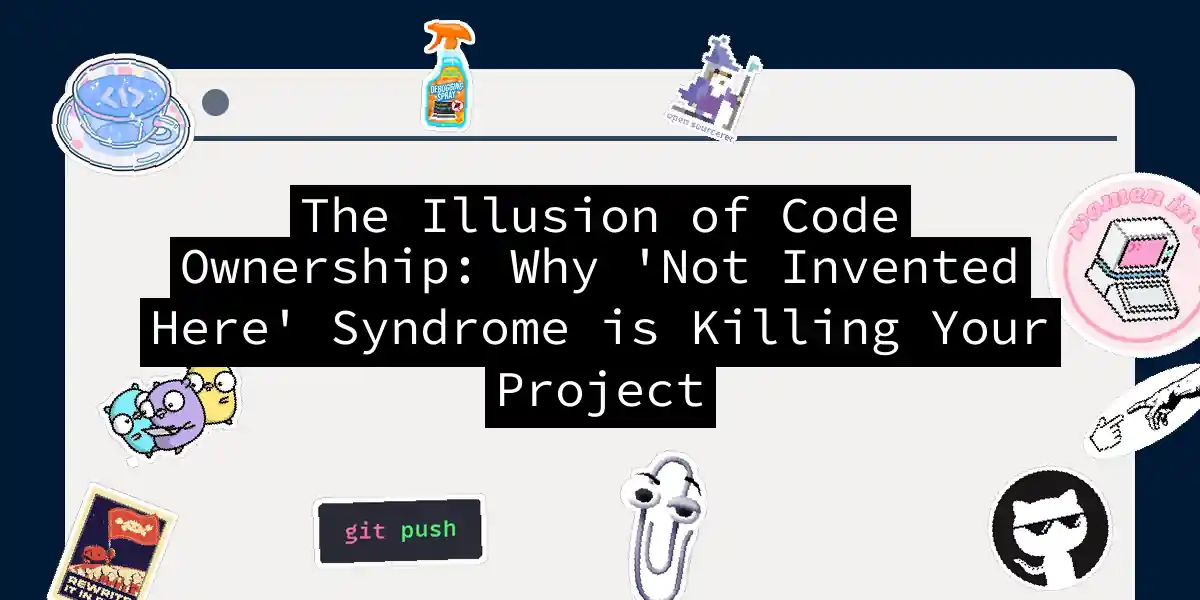The Illusion of Code Ownership: Why ‘Not Invented Here’ Syndrome is Killing Your Project
In the world of software development, there’s a silent killer lurking in the shadows, ready to pounce on your project and suffocate its potential. It’s not a bug, nor is it a misconfigured server; it’s something far more insidious: the “Not Invented Here” (NIH) syndrome. This phenomenon is as old as the hills, yet it remains a pervasive problem that can stifle innovation, waste resources, and drive your team to the brink of madness.
What is Not Invented Here Syndrome?
NIH syndrome is a decision-making error where teams or individuals prefer to develop solutions internally, even when perfectly viable external options are available. This isn’t just about being proud of your own work; it’s a deep-seated bias that can lead to reinventing the wheel, ignoring external expertise, and ultimately, hindering progress[1][2][4].
Imagine you’re at a dinner party, and someone suggests using a tried-and-true recipe from a renowned chef. But instead of embracing the wisdom of the culinary world, you insist on creating your own recipe from scratch. Sounds absurd, right? Yet, this is exactly what happens in software development when NIH syndrome takes hold.
The Psychology Behind NIH Syndrome
So, why do we fall into this trap? It’s often a mix of pride, fear of change, and a desire to maintain control or ownership of ideas and projects. When you create something yourself, you feel a sense of ownership and attachment. This attachment can lead to an irrational overvaluation of your own solutions, even if they’re no better (or sometimes worse) than what’s already available[1][2].
Real-World Examples
Let’s look at a classic example: Alexander Graham Bell and Western Union. When Bell offered to sell his telephone patent to Western Union, they rejected it, opting to develop their own version instead. This decision was a textbook case of NIH syndrome, and it cost Western Union dearly. They ended up spending more time and resources on a solution that was already available and proven[2].
In the tech world, this syndrome can manifest in various ways. For instance, a team might decide to build their own authentication system instead of using an established library like OAuth. This not only wastes time but also introduces potential security risks that could have been avoided by leveraging existing, well-tested solutions.
The Cost of NIH Syndrome
The financial and time costs of NIH syndrome are staggering. When you reinvent the wheel, you’re not just duplicating effort; you’re also delaying the delivery of your product. This can lead to missed market opportunities, increased development costs, and a slower time-to-market.
Here’s a simple flowchart to illustrate the decision-making process that often leads to NIH syndrome:
Overcoming NIH Syndrome
So, how do you break free from this cycle of self-inflicted inefficiency? Here are a few strategies:
Perform a Rigorous Cost-Benefit Analysis
Before deciding to develop something internally, conduct a thorough cost-benefit analysis. Consider factors like price, scalability, reliability, security, time, and difficulty. Ask yourself if there’s an accepted solution on the market that meets your needs without being your core differentiating technology. If so, it might be wise to adopt it[1].
Focus on the 20% That Matters
Not everything needs to be built from scratch. The 80/20 rule suggests that 80% of your features are common and can be handled by existing tools, while 20% are unique and drive real value. Focus your team’s efforts on that 20% and use external solutions for the rest. This approach not only saves time but also allows your team to concentrate on what truly differentiates your product[3].
Defensive Programming
When integrating external solutions, it’s crucial to think defensively. Assume that everything can go wrong and plan accordingly. For example, if you’re using an external API, implement caching and soft fail mechanisms to ensure your system remains functional even if the API is down.
Here’s an example of how you might handle an external API failure defensively:
Conclusion
Not Invented Here syndrome is a silent killer that can strangle your project’s potential. It’s a mindset that needs to be challenged and overcome. By recognizing the signs of NIH syndrome, performing rigorous cost-benefit analyses, focusing on what truly differentiates your product, and adopting defensive programming practices, you can break free from this cycle of inefficiency.
In the end, it’s not about who invented it; it’s about delivering the best solution possible. So, the next time someone suggests using an external solution, don’t let pride or fear get in the way. Embrace the wisdom of the community, and let your project thrive.
Remember, in software development, the only constant is change. And sometimes, the best way to innovate is to acknowledge that someone else has already invented the wheel – and that’s perfectly okay.
